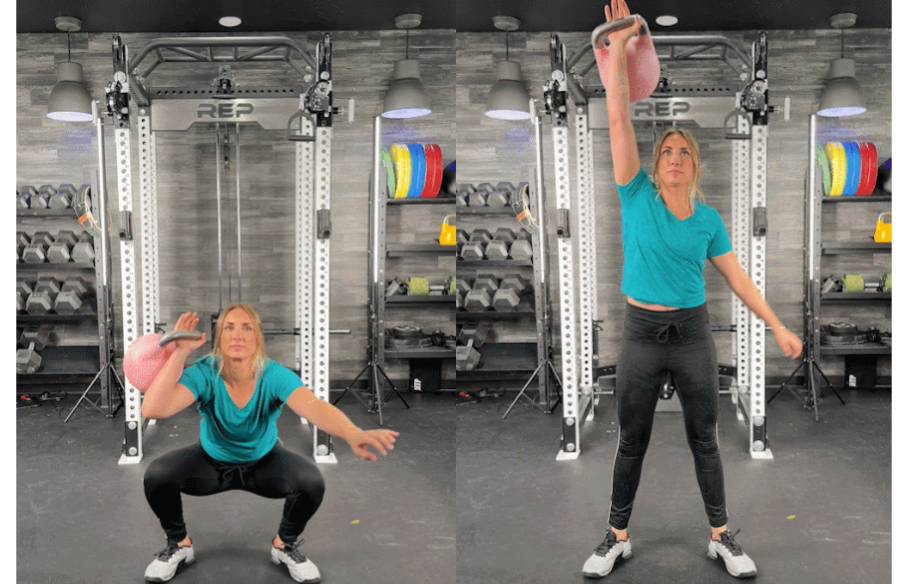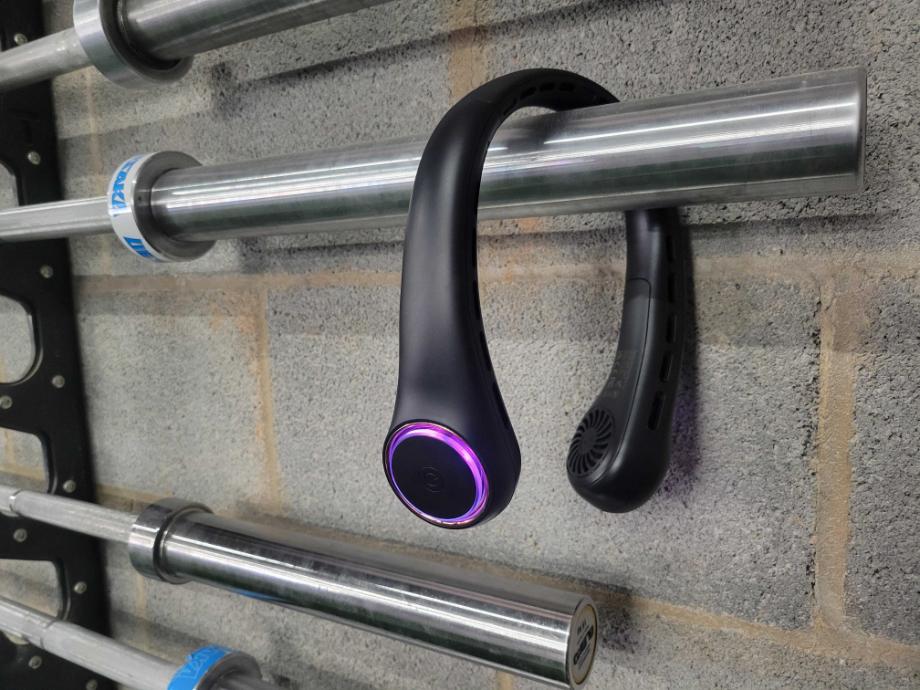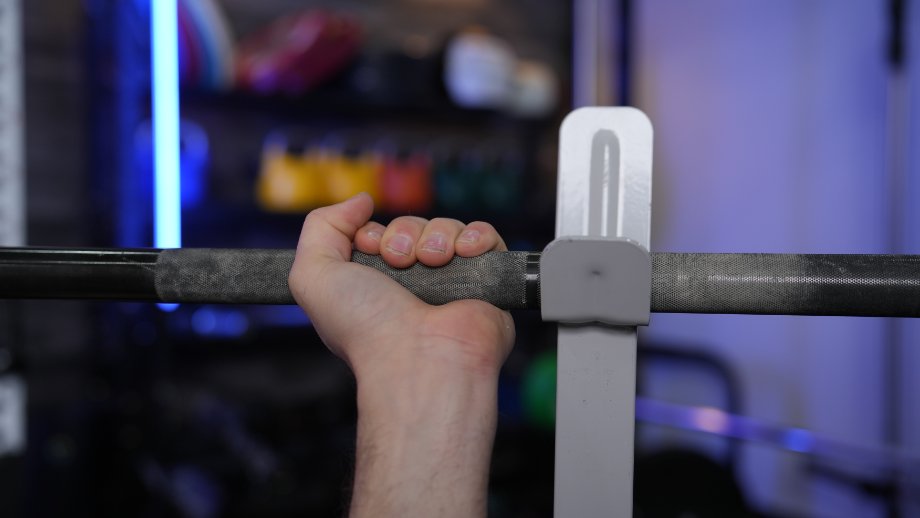Before understanding why this kettlebell core workout is fantastic for your mid-section, let’s define the core. The core, abs, or midsection (or whatever you call it) is every muscle between your ribs and your glutes—got it? Good, because contrary to popular belief, the core is much more than just the six-pack, it also includes muscles in your sides and back, such as the obliques and the erector spinae.
Now that is out of the way, let’s discuss why the kettlebell is an excellent tool to strengthen the core. The kettlebell design has a thick handle and offset center of mass compared to a dumbbell (about 6-8 inches from the handle), which has core strengthening benefits. Dumbbells tend to center the weight within your hand, but with kettlebells, this changes depending on your exercise, like kettlebell swings versus goblet squats.
RELATED: Best Kettlebells for Your Home Workout
The offset load while using the kettlebell impacts your stability. The stabilizing muscles of your core and body constantly adjust because of the shifting center of mass with each rep. This fact makes the kettlebell a great tool to improve your core strength and endurance.
Here we’ll dive into 10 great kettlebell exercises and how to do them, and we’ll tie it into a nice bow with a kettlebell workout to give you a rocking, strong core.
10 Best Kettlebell Core Exercises
Below are 10 excellent kettlebell exercises for the core. You can perform many kettlebell exercises for the core, but the ones below will give you the most bang for your buck and train every muscle group from head to toe.
1. Kettlebell Turkish Get-Up
Why do it: Besides training every muscle from head to toe, the kettlebell Turkish Get-Up improves unilateral shoulder strength because of the rotator cuff and upper back demands.
Note: It’s best to perform the Turkish Get-Up as the body weight exercise before doing it with a KB.
How to do it:
- Lie on your back holding a kettlebell in one hand with the same knee bent and the opposite leg straight. Hold the kettlebell straight up over your chest and rest your opposite arm on the floor.
- Exhale and contract your abs to lift your body up, reaching the kettlebell toward the ceiling as you sit up to balance on your opposite elbow. Straighten your arm to extend up and lift your hips off the ground to balance on your hand and foot.
- Step your other foot back under your hips to a half kneeling position and lift your hand off the floor. Press through your front foot and your back toe to stand up in a lunge position, then step your back foot forward. Keep the arm holding the kettlebell extended straight up throughout the movement.
- To reverse the movement, step back, drop to your knee, lower your hand to the ground, swing your foot forward, set your hips down, and lower your upper body back to the starting position.
- Repeat for the recommended number of repetitions on each side.
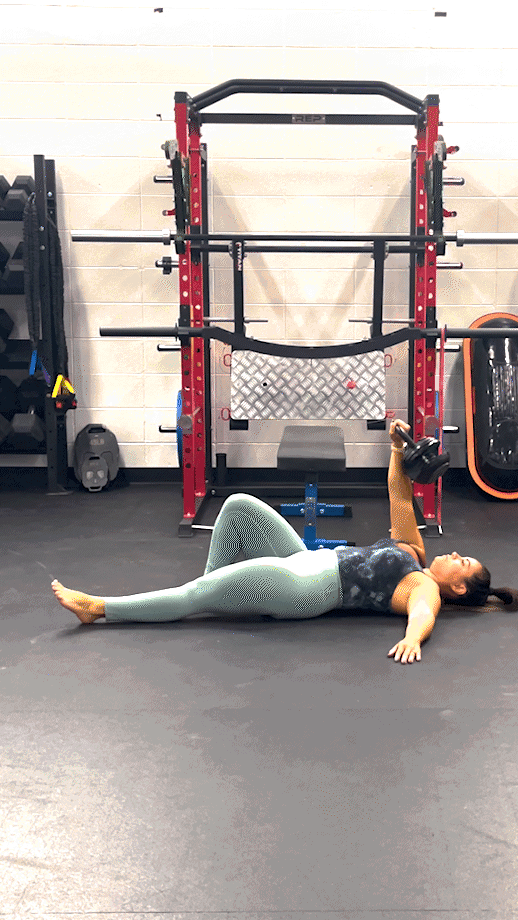
2. Kettlebell Goblet Squat
Why do it: The kettlebell goblet squat’s anterior loading acts like a counterbalance, allowing you to get into a squat easier while engaging your anterior core. (Check out our complete guide on How to Do Goblet Squats if you want to learn more.)
How to do it:
- Hold a kettlebell in front of your chest, cupping the bell in your hand as if you were holding a goblet. Step your feet shoulder-width apart.
- Inhale and push your hips back as you bend your knees to squat, lowering your body until your thighs are at or just below parallel. Keep your back straight and your weight in your heels. Allow your knees to track over your toes.
- Exhale as you press through your heels and extend through your knees and hips, squeezing your glutes to return to the standing position. Continue to hold the kettlebell steady in front of your chest as you move.
- Repeat for the recommended number of repetitions.
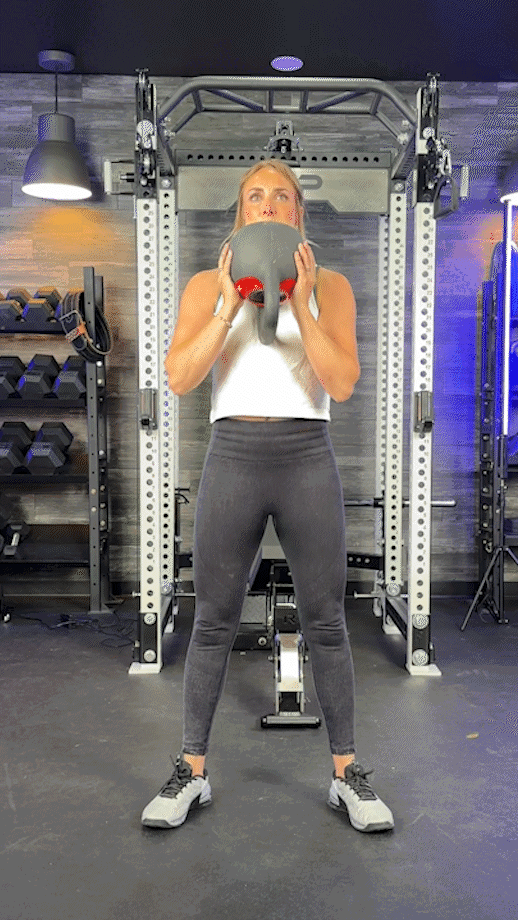
3. Kettlebell Bottoms-Up Carry
Why do it: Bottoms-up carries are performed with the kettlebell balanced upside-down and your arm overhead or in the semi-racked position. The overhead version is far harder because the load is farther from your center of gravity. Both will improve your posture, lateral stability, and grip strength, as well as strengthen the shoulder area.
How to do it:
- Start with a lighter kettlebell, in the 18- to 35-pound range, depending on your strength level.
- Grip the kettlebell horn in the middle of your palm with your wrist and elbow aligned.
- Then press overhead until your elbow is fully extended.
- Keeping the kettlebell “bottoms up,” carefully walk for 20 to 40 yards, switch hands, and repeat on the opposite side.
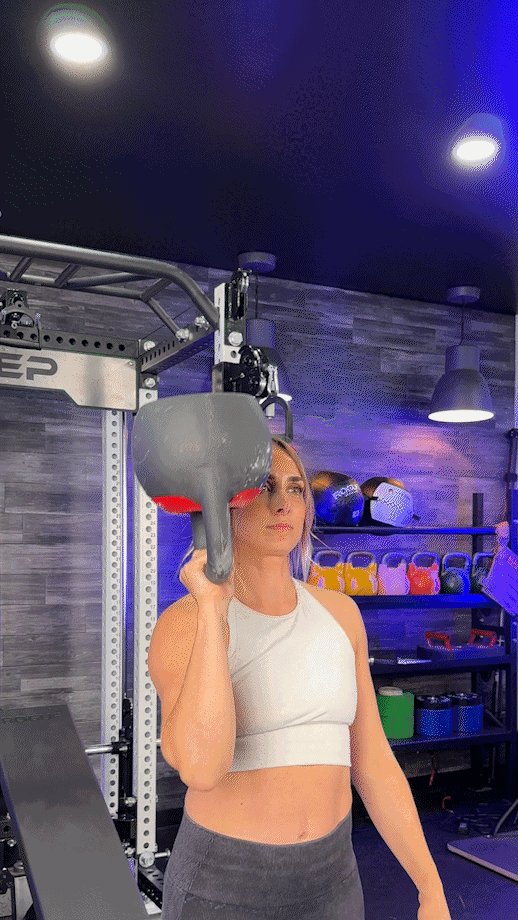
4. Kettlebell Suitcase Carry
Why do it: The kettlebell suitcase carry strengthens grip imbalances between sides and improves the look and strength of your oblique muscles.
How to do it:
- Grip the kettlebell horn in your left hand and ensure your shoulders are down and even. Check in the mirror if you have to.
- Walk carefully, keeping your left arm down and using your right arm for balance.
- Once you’ve reached the desired distance, switch hands and walk back.
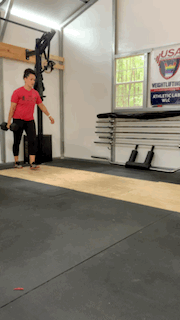
5. Kettlebell Tall-Kneeling Halos
Why Do It: The kettlebell tall-kneeling halo improves shoulder mobility, core stability, and hip mobility while increasing your anti-rotational strength.
How to Do It:
- Begin in a tall kneeling position, holding a kettlebell by the horns in front of your chest.
- Lift one elbow up and over your head, rotating the kettlebell around your head and bringing the other elbow up as you complete the circle. The full circle will bring the kettlebell back to the racked position in front of your chest. Keep your back straight and neck neutral.
- Switch directions to repeat the movement in reverse. That’s one rep.
- Repeat for the recommended number of repetitions on each side.
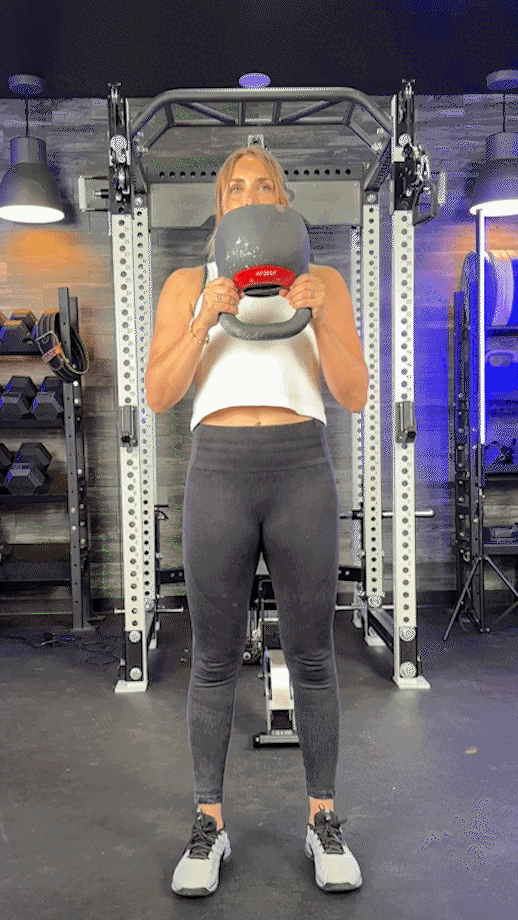
6. Kettlebell Overhead Press
Why Do It: Doing an overhead press with kettlebells demands more stability, postural control, and upper back muscle engagement. When pressing overhead, the kettlebell’s angle with your scapula makes the move easier on your shoulder joint, which is great for beginners.
How to Do It:
- Stand with your feet hip-width apart, holding a kettlebell in one hand (or a kettlebell in each hand). Clean the kettlebell up to a front-racked position.
- Rotate your arm out so your palm faces forward.
- Exhale and press the kettlebell overhead, squeezing your glutes and keeping your back straight and your neck neutral as you press. Inhale and lower back down with control.
- Reset and repeat for the recommended number of repetitions.
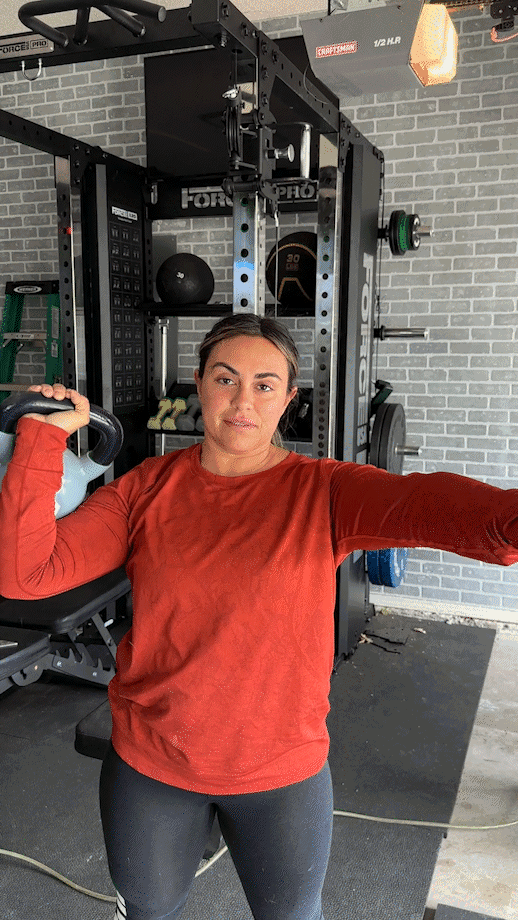
7. Half-Kneeling Kettlebell Windmill
Why do it: The half-kneeling kettlebell windmill is a great modification from the standing windmills. It trains the core in the rotational plane while going overhead, improving hip mobility and shoulder stability.
How to do it:
- Set up in a half-kneeling position; if you need extra stability, putting your back foot against a wall helps.
- With your left knee on the ground, perform an overhead press with your right arm.
- Rotate your torso and touch your left hand to the ground, keeping both arms straight and looking up at the kettlebell while you move.
- Return to the starting position and reset and repeat for the recommended number of reps.
- Switch legs and repeat the whole sequence on the other side.
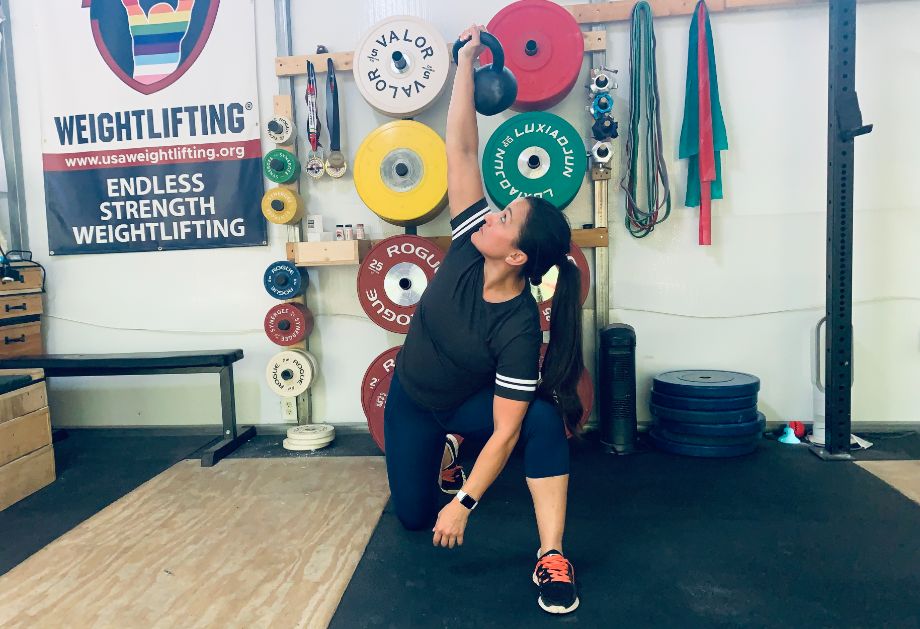
8. Kettlebell Double Front Rack Carry
Why do it: The KB double front racked carry is a simple but challenging exercise to improve upper back strength. Upper back strength is needed for complex movements like Olympic lifting and front squats.
How to do it:
- Clean a pair of kettlebells to the front rack position.
- Ensure your wrists are neutral, your shoulders are down, and your chest is up.
- Walk with a good upright posture for the required distance.
- Lower the kettlebells to the ground.
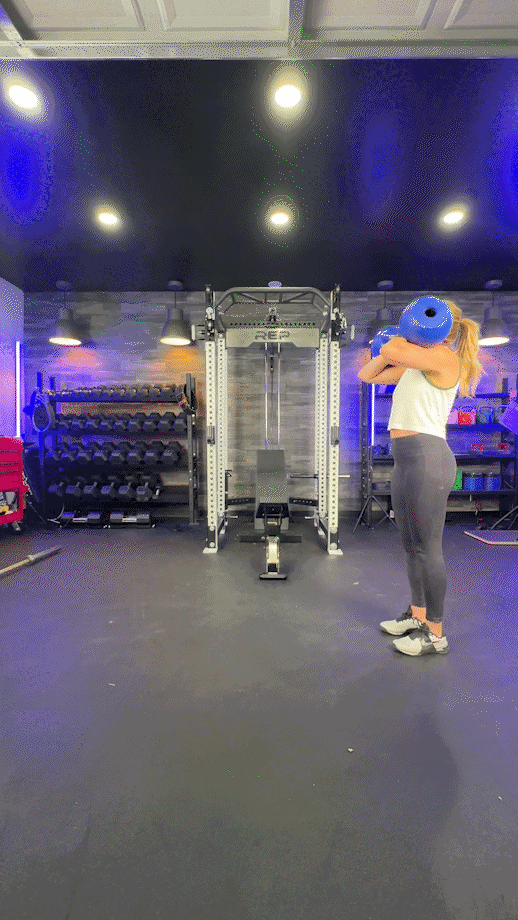
9. Single-Arm Kettlebell Swing
Why do it: The single-arm kettlebell swing trains the hamstrings and glutes for power, strength, and endurance while strengthening muscle imbalances between sides. Plus, it will increase your heart rate, which is great for cardio.
How to do it:
- Stand holding a kettlebell with your left hand. Step your feet slightly wider than hip-width apart, or as far as shoulder-width apart.
- Inhale as you hinge your hips back, dropping the kettlebell between your legs and under your hips. Keep your back straight and chest up.
- In one motion, push through your heels and extend your hips, using the momentum generated by your legs to swing the kettlebell up to approximately chest height.
- Control the swing of the kettlebell with your arms, following it back down by bending your legs and squeezing your glutes and quads to reset for the next repetition. Exhale with each swing.
- Repeat for the recommended number of repetitions.
- Switch to your right hand and repeat for the same number of reps.
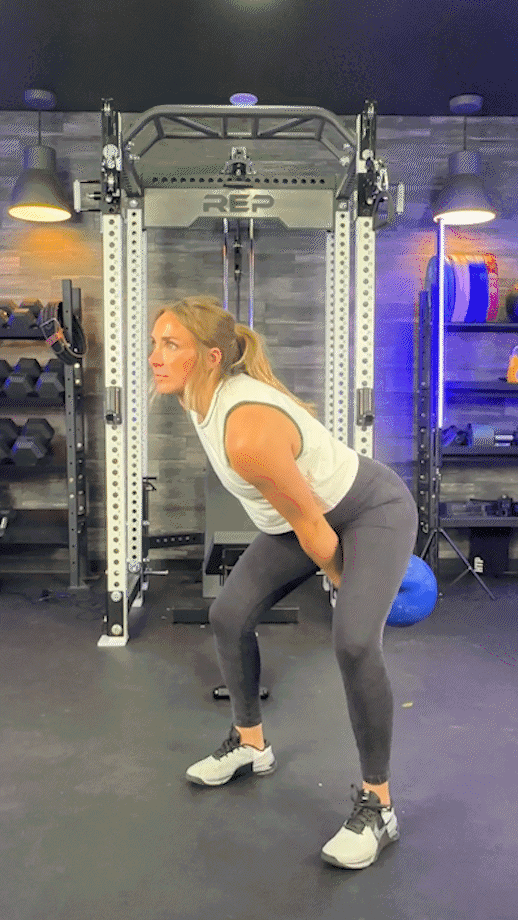
10. Kettlebell Romanian Deadlift
Why do it: The Romanian kettlebell deadlift will help improve your upper back and lockout strength for barbell deadlifts while adding muscle to your glutes, hamstrings, and lower back.
RELATED: Best Deadlift Variations
How to do it:
- Stand tall with your feet hip-width apart, holding a kettlebell in front of your quads.
- Inhale as you hinge your hips, keeping your back straight and holding your arms in front of your legs as you lower the kettlebell toward the floor. Keep your legs as straight as possible while you hinge.
- Exhale and push through your heels to engage your hamstrings and glutes as you straighten your hips pull straight up to the starting position. Keep your back straight and your chest up throughout the movement.
- Repeat for the recommended number of repetitions.
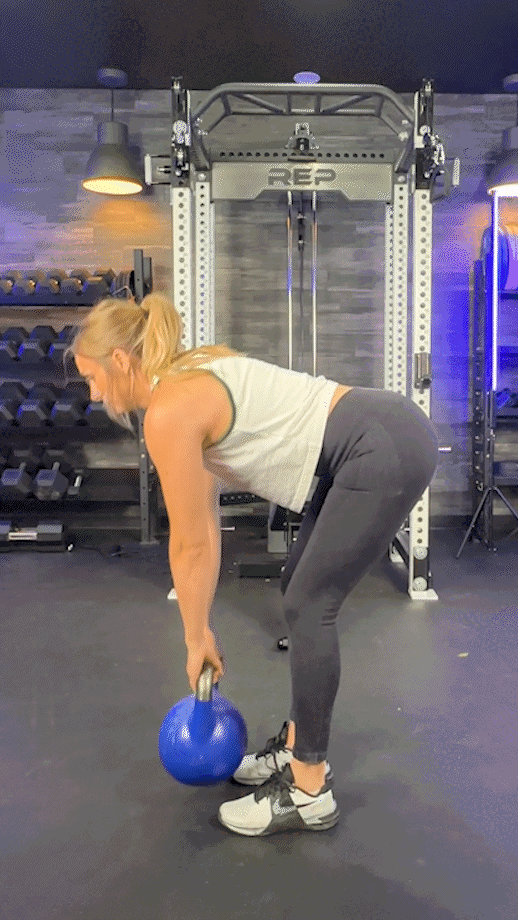
Kettlebell Core Workout
Here’s a total-body kettlebell ab workout performed with a pair of kettlebells. Perform the five exercises in a circuit, resting as little as possible between exercises and 2 minutes after each circuit. Perform 3-4 circuits and do them in place of your usual workout when your core strength needs a boost.
Circuit: Perform 3-4 rounds
- Kettlebell Turkish Get-Up, 3 reps on each side
- Single-Arm Kettlebell Swing, 10-15 reps with each arm
- Kettlebell Overhead Press, 6-8 reps
- Kettlebell Front Racked Carry, 40 yards
- Kettlebell Romanian Deadlift, 8 reps
Rest 2 minutes between rounds
What Muscles Do Kettlebell Core Workouts Train?
Now, I did mention the core is more than just the abs, but here we will discuss the core’s four main muscles that are important for upper and lower body movements.

Rectus Abdominis
The rectus abdominis runs vertically up the front of the torso, and its primary functions are spinal flexion (crunches) and anti-extension (plank position). The rectus abs are targeted during kettlebell core workouts and are resilient to fatigue because it’s an area dominant in slow twitch muscle fibers. That’s why training the core for strength and endurance is essential.
RELATED: Best Core Exercises Equipment
Obliques
The obliques are made up of two muscles, the internal and external obliques. The obliques run beside the rectus abs from the pelvis, hips, and rib cage. The internal obliques are under the external obliques, and the muscle fibers travel perpendicularly. They’re responsible for the rotation of the upper body and anti-rotation of the lower back.
Transverse Abdominis
The transversus abdominis plays the same role in the core as a belt does to tighten your loose pants. When engaged, the TA helps maintain abdominal tension, which increases intra-abdominal pressure and protects your back under heavy loads. It sits under your rectus abs and obliques and wraps around your spine.
Erector Spinae
The Erector Spinae comprises three long muscles that run from the lower back to the cervical spine and posterior and laterally to the spinal column. These three muscles support and protect the spine from heavy loads and control the movements of the head and spine.
Benefits of Using a Kettlebell for Core Workouts
There are various tools and workouts that are great for training the core, but the kettlebell is unique for one reason. Its offset load means the hip, shoulder, and core stabilizers work overtime to keep you balanced.
Improving the strength and endurance of the core and core stabilizers with kettlebells reduces your chances of lower back injuries. It prevents energy links from your lower to the upper body when lifting or performing athletic movements. When you have low enough body fat, performing kettlebell core workouts will help make your abs pop.
RELATED: Kettlebell Cardio Workout
Kettlebell Core Workout: Final Thoughts
Look no further than the kettlebell core workouts above to increase your core muscles’ strength and endurance. The unique shape of the kettlebell will challenge your core like never before. Kettlebell core workouts will improve:
- Grip strength
- Shoulder stability and mobility
- Cardiovascular endurance
- Core strength and endurance
Kettlebell Core Workout: Q&A
Are kettlebells good for your core?
Training with kettlebells is excellent for core training because their unique shape and offset center of mass forces your core muscles to engage to keep you upright and balanced.
What happens if you do 100 kettlebell swings a day?
If you perform 100 proper form kettlebell swings a day, you’ll improve your grip strength, improve your glutes and hamstrings, and strengthen your heart. Continuous KB swings improve your Vo2 max, improving your conditioning.1
How do you use a kettlebell for the core?
By performing full-body workouts with the kettlebell, you will train your core because the kettlebell’s unique shape ensures your core muscles will engage to keep you upright and balanced so that you can perform kettlebell exercises with good form.
Do kettlebells flatten your stomach?
Kettlebells are an excellent tool for fat loss and to help flatten your stomach, but you cannot out-exercise a poor diet or excess calories. Flattening your stomach involves work in the kitchen, too.
References
- Farrar RE, Mayhew JL, Koch AJ. Oxygen cost of kettlebell swings. J Strength Cond Res. 2010 Apr;24(4):1034-6. doi: 10.1519/JSC.0b013e3181d15516. PMID: 20300022.


